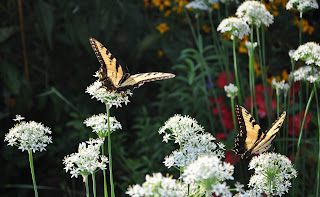A perennial that excels in both form and function is the garlic chive. It looks lovely in spring, summer and fall. In the spring, its clumps of bright green blades are the first herbs to emerge from their winter slumber. I can start cutting them for light use just weeks after they emerge. In summer they become a cooling foil for the brilliant colors that abound in this garden. In late summer the garlic chives put up strong stems and clusters of clean white flowers that wave in the breeze and attract both bees and butterflies. In fall the shapely seed heads add some interest to the front of the beds.
 |
| A Tiger Swallowtail Butterfly enjoying the garlic chive blossoms. |
 |
| Many other beneficial insects and pollinators visit the garlic chive flowers as well. |
Cultivation and Propagation
Garlic chives are a hardy perennial. They form tight clumps that can be divided and replanted to propagate and they will self seed. If started from seed the seeds should be planted indoors 4-6 weeks before the last frost, sprinkle 10-15 seeds evenly distributed on top of the soil in the seed cells, cover with planting mix 1/8 to 1/4' thick over the seeds and firm. Keep evenly moist and feed once the sprouts emerge. For best results keep under artificial until danger of frost has passed, (follow the link to see my blog post on starting seeds indoors). They need full sun and like good rich soil and lots of water, they will take what they are given as far as water goes but they don't like shade.
Nutritional Information
Garlic chives are high in vitamin C as well as Vitamin A, and Potassium. They contain high amounts of carotene, Vitamin B1, (thiamine) and Vitamin B2, (riboflavin) and a substantial amount of calcium and iron as well as other minerals.
Culinary Uses
The blades of garlic chives are best used raw in order to make the most of their nutritional value. They can be added to green salads, potato salad, chicken salad or tuna salad, or sprinkled on cooked foods like fish, right before being served. One of my favorite ways to use them is in Oi Sobagi, (follow the blue link for the recipe which is on my other blog A View From the Cottage), a Korean naturally fermented kimchee that is a staple at our house.
Medicinal Uses
Traditionally, the blades of chives were used internally to treat intestinal parasites, to aid in digestion and boost the immune system. Topically they were bruised and used to take the sting out of a bee sting or treat a bug bite. The whole plant is antibacterial.The seeds are used to treat kidney and liver disorders.
Harvesting
You can start cutting the blades of garlic chives once they are 8-10 inches tall. Do not cut closer than 4" from the point where the blades split away from each other, about 4- 6 inches from the ground. If you have more than one clump, then take some from each clump rather than cutting it all from the same plant. I try to leave some tall blades on each clump for aesthetic purposes, but it is alright to cut them all, the plants will put up new blades post haste. The blossom stalks can be cut when the blooms are still tight buds and used in Asian cuisine, but I am very fond of the blooms in my garden and like to save the seed, so I don't cut the blooms.
To save the seed, when the seed heads start to turn yellow, cut the stalks just above the blade tips and hang upside down to dry. Put a container under the seed heads to catch the seeds that will begin to pop out as the heads dry, or Cut the heads from the stalks and use dehydrator trays or baking sheets to dry the seeds heads, or do what I do and use a Stack!t herb drying unit, cut the heads off and distribute evenly on the netting, leave in a spot with good air circulation until the seed heads are brown and papery and the black seeds are easily removed. Remove chaff by gently rubbing the seed heads between your hands and then blowing chaff away, (best done outside to reduce the mess, but use a tray under your hands so you don't lose your
 |
| These seed heads are ready for harvest. |
 |
| Stalks are long and Seed heads are born high above the blades so you can harvest the seed heads for hanging while leaving the blades on the plant. |
 |
| Distribute the seed heads evenly, leaving air space between the heads. |
*All photos were taken by me unless otherwise noted. Please don't use my photos without asking me first...



No comments:
Post a Comment